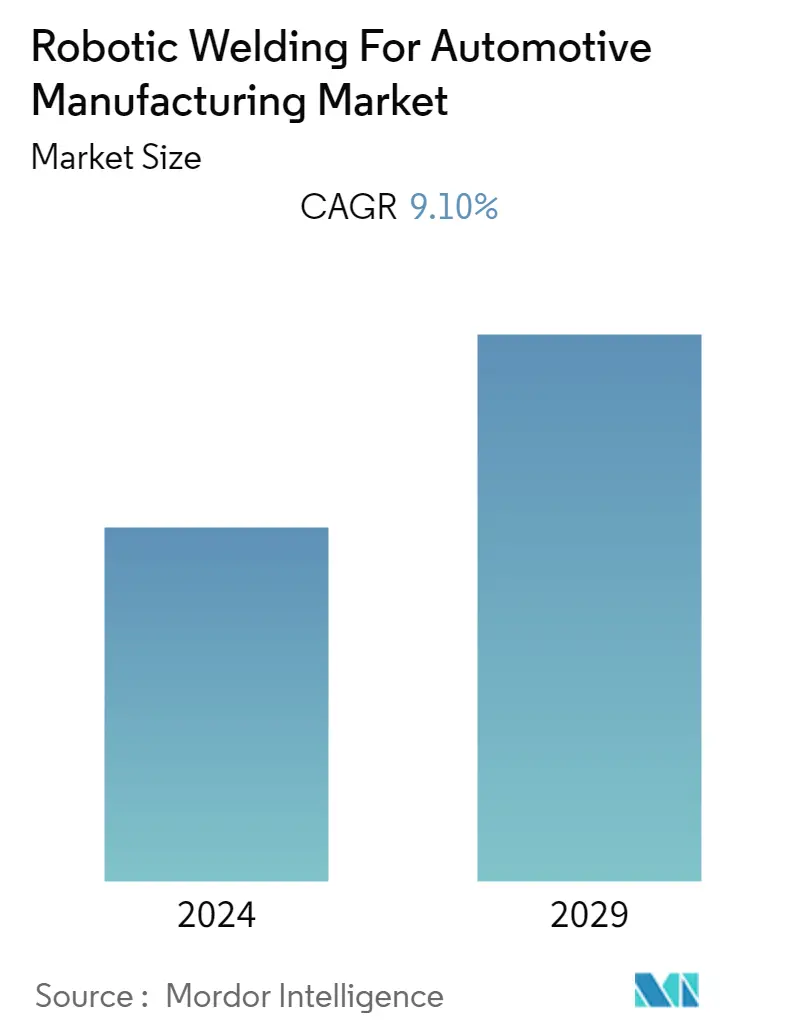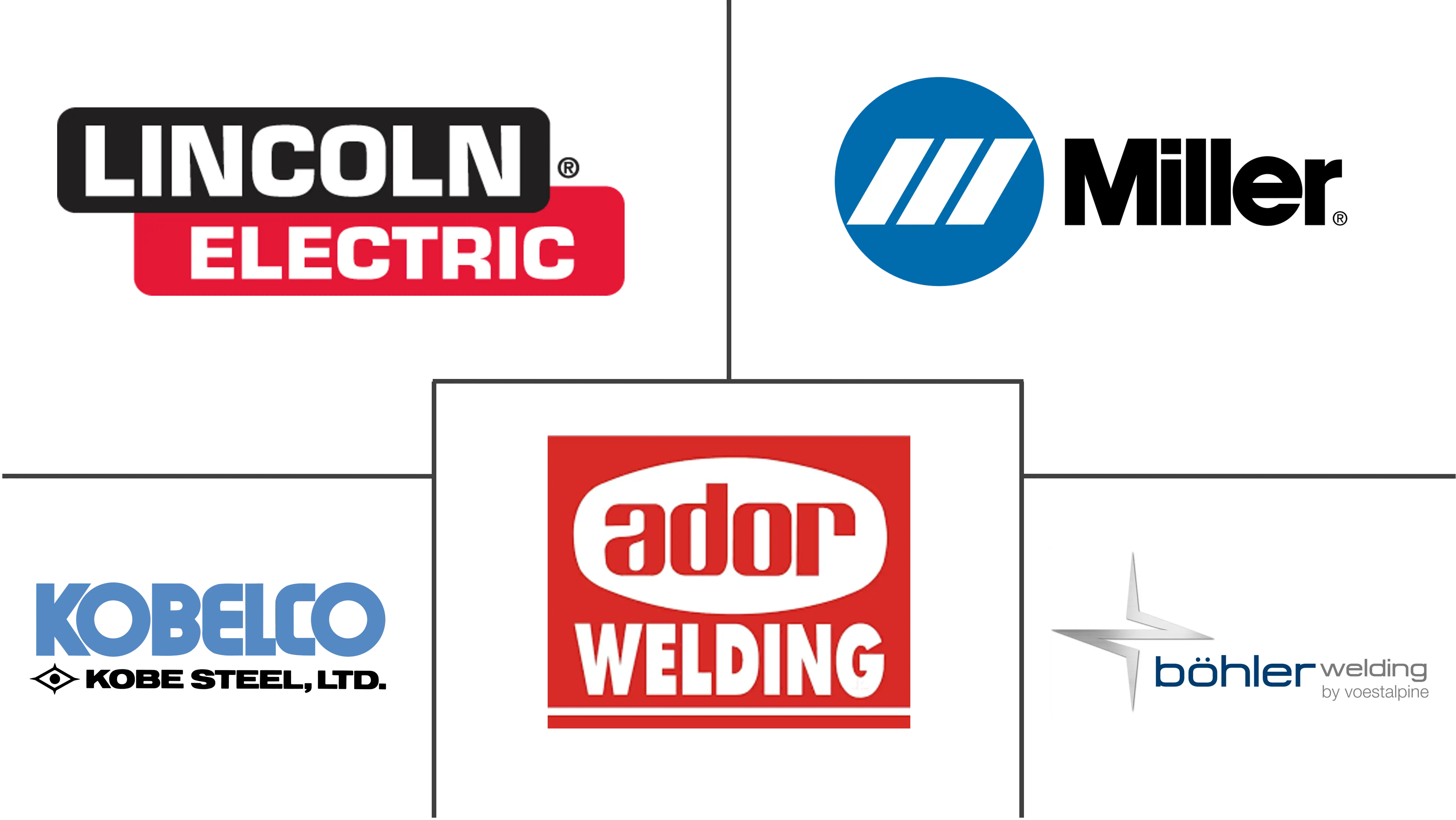Market Size of Robotic Welding For Automotive Manufacturing Industry

| Study Period | 2019 - 2029 |
| Base Year For Estimation | 2023 |
| CAGR | 9.10 % |
| Fastest Growing Market | Asia-Pacific |
| Largest Market | Europe |
| Market Concentration | Medium |
Major Players
*Disclaimer: Major Players sorted in no particular order |
Robotic Welding for Automotive Manufacturing Market Analysis
The global robotic welding market for the automotive manufacturing market is projected to grow at a CAGR of 9.10% during the forecast period. COVID-19 has had an unprecedented and astonishing impact globally, with robotic welding seeing a positive impact on demand across all regions during the epidemic. The increase in CAGR is due to the demand and expansion of this market, which will revert to pre-pandemic levels once the pandemic is over.
- Robotic welding is an automated procedure that uses mechanized, programmed tools to weld and handles equipment in the industry. Industrial robots are becoming increasingly important in a variety of industries, like the automotive industry. Furthermore, the use of robots has resulted in exceptional results in terms of surface polish and dimensional accuracy throughout the sector.
- The automotive industry is anticipated to increasingly use robotic welding as a result of the transforming automotive industry. The industry has been known to use complex technology in order to make the most of high tensile strength steel for a robust assembling process. Spot welding is likely to have an impact on the expansion of these technologies in the automotive industry.
- The increasing global demand for automobiles is a major element driving the robotic welding growth. In addition, increased human-safety concerns in vehicle production plants are driving up demand for small, medium, and high-payload welding robots. In the automotive industry, a more complicated system is required for uninterrupted flow. Welding robots are given a range of commands to keep the assembly process moving. Using an autonomous robotic welding system, the machine is involved in the whole line function.
- Additionally, in 2020, the COVID-19 outbreak and spread had a negative impact on the robotic welding market, resulting in lower shipments of welding robots and associated peripherals. As a result, the revenue earned by them has decreased. As a result, the market's growth trajectory slowed significantly in the first half of 2020. This pattern persisted until the first quarter of 2021.
- However, low-skilled workers are progressively being replaced and displaced by welding robots. In the long run, however, reskilling and upskilling would result in the creation of more jobs in the majority of developed countries, but not in developing countries, where the proportion of low-skilled workers is far larger. The adoption of automation in emerging countries may have a detrimental impact because SMEs make up the bulk of any industry and are also the largest employees.
Robotic Welding for Automotive Manufacturing Industry Segmentation
Robotic welding is capable of meeting a variety of automotive and transportation industry needs. As a result, automakers are investing heavily in implementing smart manufacturing technologies in their factories. Due to their extended arms and enormous payload capacities, big robots are commonly utilized to spot weld large vehicle body panels.
Smaller robots, on the other hand, may be able to weld lightweight parts like brackets and mounts. Robotic MIG and TIG welders are also popular because their torches may remain in the same position during each cycle. These robots can achieve acceptable welding standards because their arc and speed gaps are repeatable.
Additionally, the market scope comprises products such as Resistance Spot Welding, Resistance Seam Welding, Laser Beam Welding, and others (Metal Inert Gas (MIG) Welding, Friction Welding, Medium Frequency Welding, Magnetic Pulse Welding, etc.).
| Product | |
| Resistance Spot Welding | |
| Resistance Seam Welding | |
| Laser Beam Welding | |
| Others (Metal Inert Gas (MIG) Welding, Friction Welding, Medium Frequency Welding, Magnetic Pulse Welding, etc.) |
| Geography | |
| North America | |
| Europe | |
| Asia Pacific | |
| Rest of The World |
Robotic Welding For Automotive Manufacturing Market Size Summary
The robotic welding market within the automotive manufacturing sector is experiencing significant growth, driven by the increasing demand for automation and efficiency in production processes. This market is characterized by the use of mechanized, programmed tools to perform welding tasks, which enhances surface polish and dimensional accuracy. The automotive industry is particularly poised for growth in this area due to its adoption of high tensile strength steel and complex technologies for robust assembly processes. The rise in global automobile demand, coupled with heightened safety concerns in manufacturing plants, is propelling the adoption of robotic welding systems. These systems are integral to maintaining an uninterrupted assembly flow, with robots executing a range of commands to streamline production.
The market is further bolstered by the expansion of manufacturing facilities for electric vehicles and the increasing investment in automation technologies by both established and emerging manufacturers. Notable partnerships and investments, such as ABB's collaboration with Ola in India and BMW's agreement with KUKA AG, highlight the growing integration of robotic welding systems in production lines. The demand for these systems is expected to rise as new electric vehicles enter the market, with significant investments in North American manufacturing and the adoption of automation in European countries like Germany, Italy, and France. Key players in the industry are focusing on enhancing programming skills and introducing new technologies to meet the rising competitive costs and industry demand, ensuring the efficient deployment of automation technology in industrial welding.
Robotic Welding For Automotive Manufacturing Market Size - Table of Contents
-
1. MARKET INSIGHTS
-
1.1 Market Overview
-
1.2 Industry Attractiveness -Porter's Five Forces Analysis
-
1.2.1 Threat of New Entrants
-
1.2.2 Bargaining Power of Buyers
-
1.2.3 Bargaining Power of Suppliers
-
1.2.4 Threat of Substitute Products
-
1.2.5 Intensity of Competitive Rivalry
-
-
1.3 Industry Value Chain Analysis
-
1.4 Impact of COVID-19 on the Market
-
-
2. MARKET SEGMENTATION
-
2.1 Product
-
2.1.1 Resistance Spot Welding
-
2.1.2 Resistance Seam Welding
-
2.1.3 Laser Beam Welding
-
2.1.4 Others (Metal Inert Gas (MIG) Welding, Friction Welding, Medium Frequency Welding, Magnetic Pulse Welding, etc.)
-
-
2.2 Geography
-
2.2.1 North America
-
2.2.2 Europe
-
2.2.3 Asia Pacific
-
2.2.4 Rest of The World
-
-
Robotic Welding For Automotive Manufacturing Market Size FAQs
What is the current Robotic Welding For Automotive Manufacturing Market size?
The Robotic Welding For Automotive Manufacturing Market is projected to register a CAGR of 9.10% during the forecast period (2024-2029)
Who are the key players in Robotic Welding For Automotive Manufacturing Market?
Lincoln Electric Holdings Inc, Miller Electric Manufacturing LLC, Kobe Steel Ltd, Ador Welding Limited and Voestalpine Bohler Welding GmbH are the major companies operating in the Robotic Welding For Automotive Manufacturing Market.

